
Finishing an attic can make a great addition to your home. This guide breaks down the cost to finish an attic, including labor, materials, and more.
No kitchen is one-size-fits-all, so find the right layout for you


Whether you’re designing a kitchen from scratch or upgrading your current space, it’s important to know the types of kitchen layouts to determine what will work best for your home.
There are several basic kitchen layout types—one-wall, galley, L-shaped, U-shaped, island, and peninsula—and a few common variations seen in larger homes. But before you start tearing out your cabinets to build your dream kitchen, research what layout meets your needs and talk it over with a local kitchen remodeling pro.
Unless you have extensive experience in construction or interior design, it’s likely that you won't have all the answers when planning your kitchen remodel. That's why it pays to work with a professional kitchen remodeler in your area who can help guide you through the process from beginning to end. Let’s take a look at the most common kitchen layout ideas to find the best fit for your home.
The term “ergonomics” is a scientific one that refers to how spaces and appliances are designed and arranged, aiming to make them more safe and efficient for human use.
This is quite a technical definition. But what exactly does it mean in the context of how you choose to design your kitchen? Kitchen ergonomics is important because you want your kitchen to be a safe space tailored specifically to your needs, wants, and practices.
Maybe you spend ample time cooking delicious meals or washing a seemingly endless stack of dishes. When doing so, it’s quite the hassle to call someone else to get a bowl from a cabinet that’s out of reach. And having to dash back and forth between the sink and stove can become quite the inconvenience. So, if there’s a kitchen remodel in your future, it’s well worth it to sit down and dare to dream. Envision what the ideal kitchen layout looks like for you, and then bring that design to life.
An ergonomic kitchen promotes better physical health and comfort by lessening the strain on your body, which makes the time you spend in your kitchen much more enjoyable and productive. Consider the following ergonomic factors when designing your kitchen:
Height: Factor in the height of individuals in your household and your appliances when designing a kitchen layout. You’ll want all appliances to be within a comfortable reaching height, which eliminates the need to bend and stretch.
Kitchen Routes: Realistically, you’ll move around a lot in your kitchen. Especially on busy mornings, it’s all too easy to nearly collide with another family member while getting cereal or coffee. To avoid this mishap, identify the routes and habits of each household member and make sure they don’t interfere.
Options for right-handed and left-handed people: An ergonomic kitchen takes into account whether or not users are right- or left-handed. This decision will affect the placement of door handles and other appliances, making for a more natural user experience.
Lighting: Kitchen lighting can be an overlooked (but important) feature of a kitchen. By ensuring that the entire kitchen is properly lit, you’ll avoid both blinding lights and dim spaces.
Item placement: Think about where you’ll store all your plates, pots, pans, and other utensils. The placement of everything from a waste disposal to a dish sponge can improve or diminish your kitchen experience.

The layout: Kitchen with the sink, stove, and fridge arranged in a triangle
Good for: Horseshoe-shaped kitchens, small- to medium-sized kitchens, single-cook households
The kitchen triangle, also known as the “working triangle” and the “golden triangle,” is a theory that the kitchen sink, the oven, and the refrigerator should form a triangle. This shape helps the cook move from prepping, cooking, and storage with maximum efficiency.
Each side of the triangle should be 4 to 9 feet long. The legs don’t have to be equal, but their sum should not be less than 13 feet or more than 26 feet. These guidelines allow efficient rotation between the kitchen’s three main work areas.
The kitchen triangle theory can work well for your design, especially if you have one cook at home. It’s also a good idea to talk to your contractor about adding modern work zones, self-contained areas that keep everything you need in one space. For instance, your prep zone would contain your knives, cutting boards, and mixing bowls and be near your trash can.
Sufficient space around appliances for ease of movement
Efficient rotation between the sink, oven, and fridge
Ideal for a one-cook home
Not ideal for more than one cook
Insufficient space for leisure and guests
Not conducive with every kitchen layout

The layout: Kitchen with all cabinets, countertops, and appliances on one wall
Good for: Apartments, studios, condos, or smaller homes
The one-wall kitchen layout design corrals all of your cabinets, kitchen countertops, and appliances against a single wall so you can move easily between prepping, cooking, and cleaning. It’s ideal for saving space while maintaining efficiency, and it’s cost-effective compared to other kitchen layouts because it requires the least amount of materials and labor.
Modern kitchens with this layout often add an island opposite the one wall if there is space, transforming it into what is technically a galley kitchen. The island provides extra storage and counter space and allows you the opportunity to move appliances, such as a coffee maker or a microwave, away from the main wall to free up space.
A one-wall kitchen with or without an island works well if you want an open-concept floor plan but have a smaller space.
Reduces flow of traffic creating an open working space with minimal barriers
One of the least expensive kitchen layouts
Easy to design, plan, and execute
Limited countertop space
Not ideal for multiple cooks
Single-Wall Kitchen Design Example:
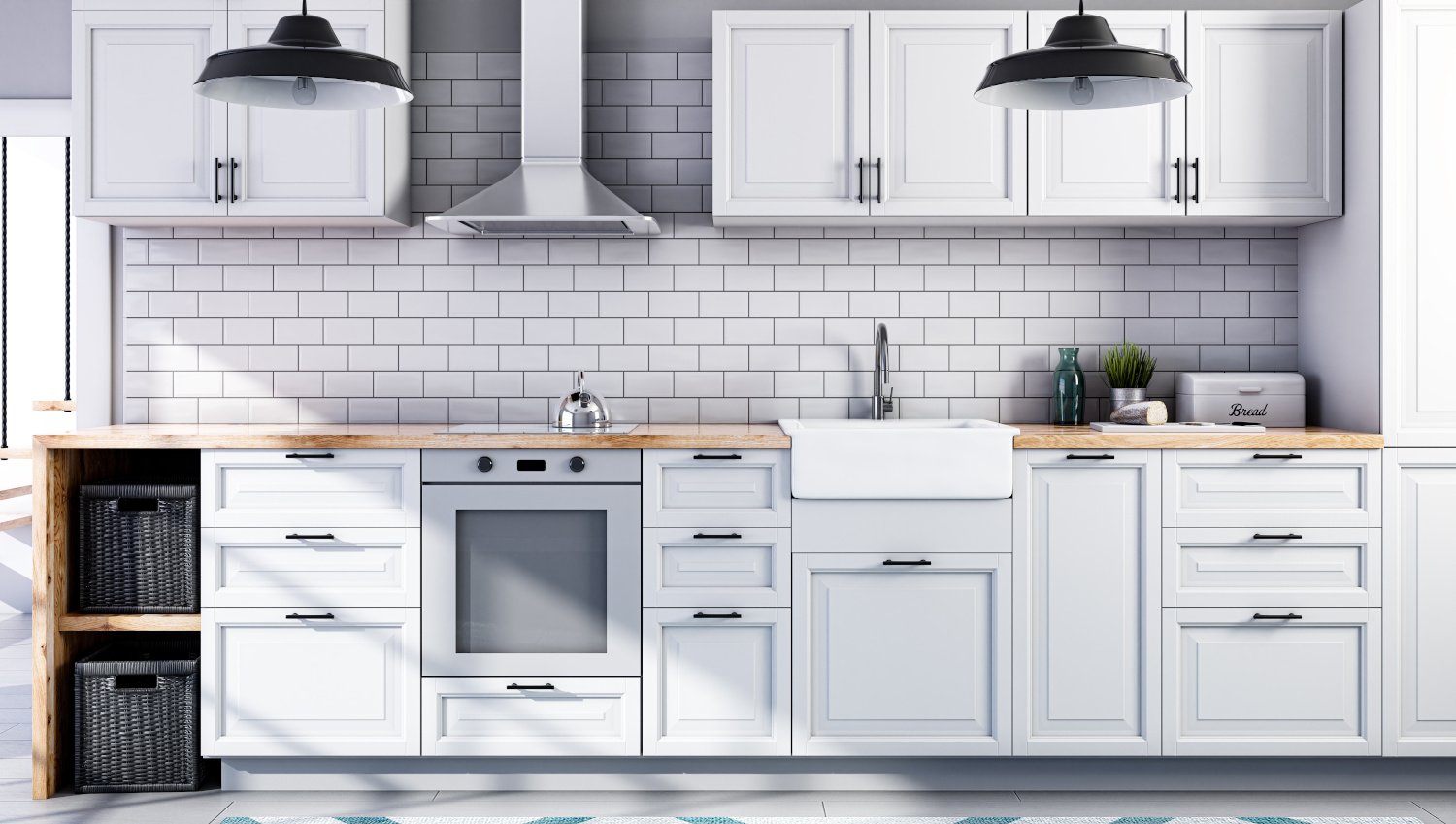

The layout: Kitchen with parallel countertops and a walkway between them
Good for: Small spaces, but can be used for larger spaces
Galley kitchen layouts are named for the type of kitchen often found in ships, and they make use of limited space with two parallel countertops and a walkway between them. The kitchen’s appliances are generally found on both sides, while vertical storage space like ceiling-hung cabinets and hanging pot racks are above them. Since everything is close together, busy home cooks who love to maximize their efficiency usually prefer galley kitchens.
If you’re thinking of remodeling your kitchen into a galley design, keep the refrigerator, sink, and stove close together to maintain efficiency. A good rule of thumb is no more than 8 feet apart. It’s also important to ensure there is at least 4 feet of space between the parallel countertops (especially if there’s more than one cook in the kitchen).
Opt for light kitchen paint colors and white cabinets to make a galley kitchen feel more spacious. You can also get the feel of the galley kitchen while keeping the space more open by placing a kitchen island along one wall and your cabinets and countertops along the other.
One of the major benefits of a galley kitchen is that it doesn’t have corner cabinets, making it easier to configure and can save money on building costs. But if you want extra countertop space (and more cabinet space), you can transform a galley into a horseshoe kitchen by closing off one wall.
Highly functional and cost-efficient
Maximizes a smaller space
More available space for work and appliances
Utilizes the kitchen triangle
Can feel cramped
Not ideal for more than one cook
Limited seating and storage space
Galley Kitchen Design Example:
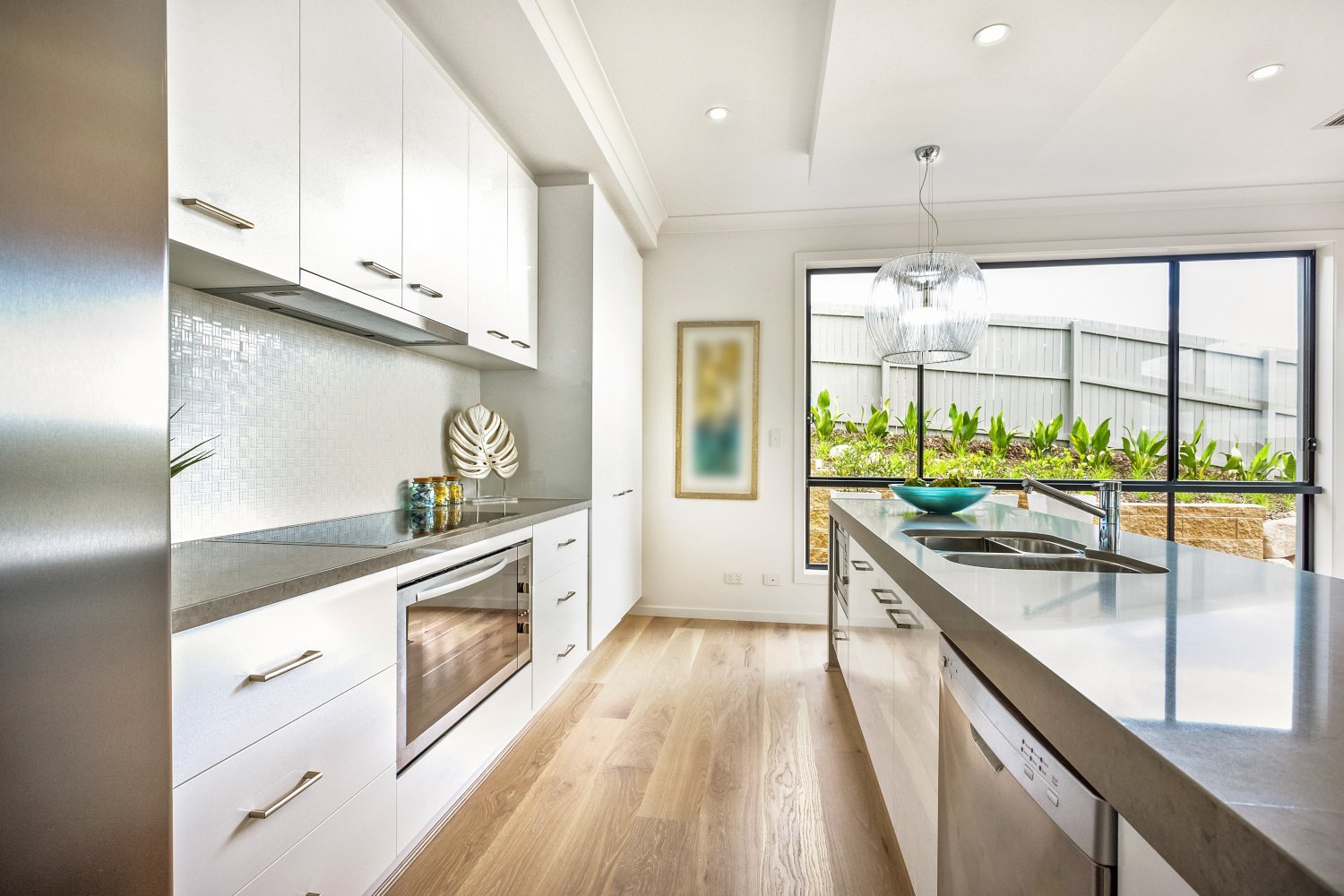

The layout: Kitchen with perpendicular countertops that form an L shape
Good for: Creating an open layout in small and medium-sized kitchens
The versatile L-shaped, or corner kitchen layout, is the most common because it allows even the smallest kitchens to have an open-concept feel. Kitchen layouts with an L shape typically have countertops and appliances on two perpendicular walls that join together. This layout sometimes includes a small kitchen table placed in the open space, and it keeps traffic flowing thanks to the open design.
L-shaped kitchens have a long leg and a short leg. If you are considering an L-shaped layout for your kitchen renovation, put your cabinets and appliances against your longest wall. This long leg will also provide the majority of counter space. Your shorter leg will likely contain an appliance, such as the stove, and a small bit of counter space. Even the smallest of L-shaped kitchens should be able to accommodate two cooks at once.
The biggest downside to an L-shaped design is the limited counter space, especially if you have a smaller kitchen. Nonetheless, the L shape is one of the few layouts that can fit into a kitchen as small as 100 square feet, so this may be unavoidable.
If you have room, try incorporating an island for extra counter space. Or extend the L to add multiple work zones. Remember to keep them less than 15 feet long—anything longer and moving between spaced-out appliances can slow you down.
Ideal layout to include an island or additional seating
Open design plan
Limited counter space, especially in smaller kitchens
May not be ideal for more than one cook
L-Shaped Kitchen Design Example:
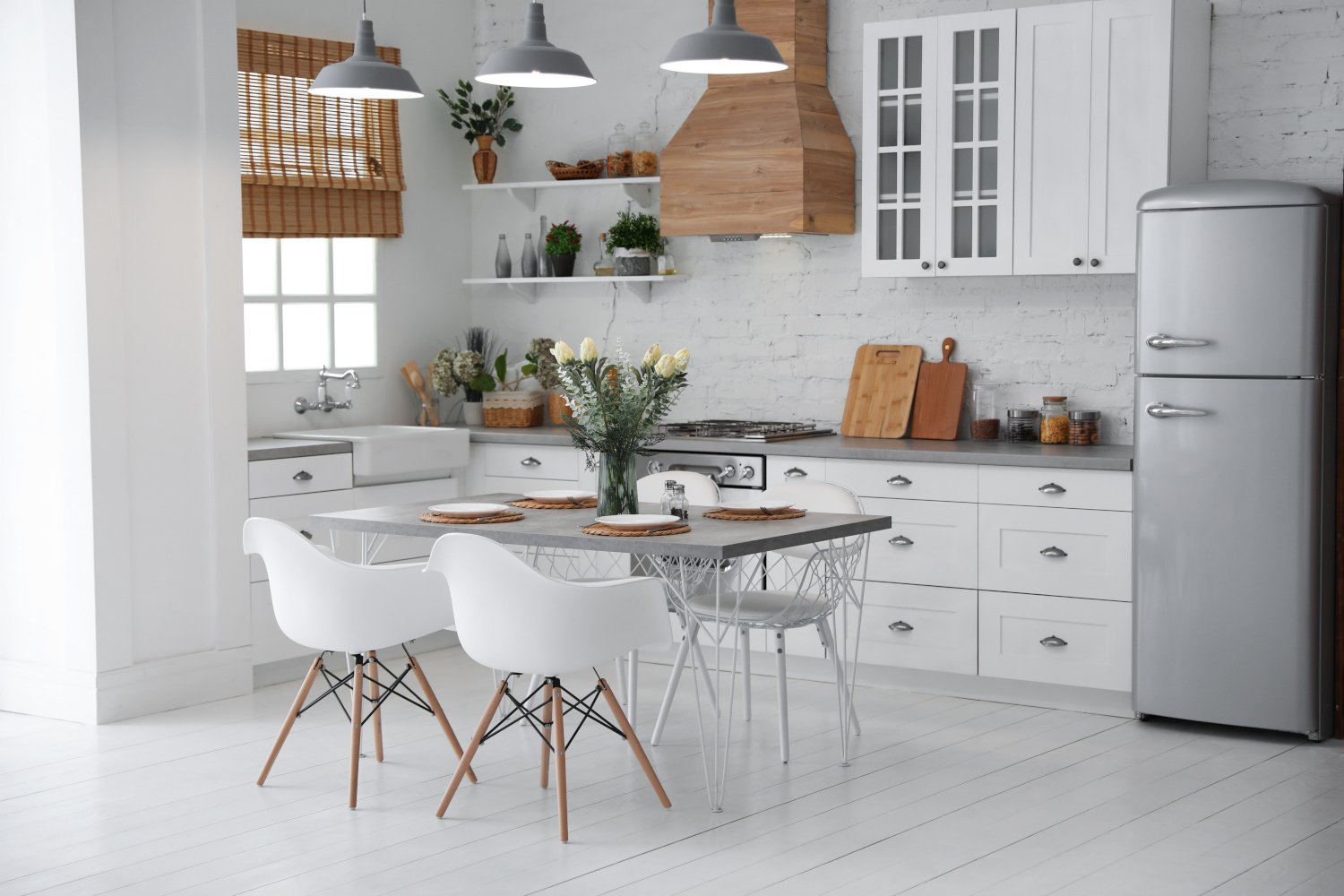

The layout: Kitchen with three walls of counters, cabinets, and appliances that form a U shape
Good for: Medium and large kitchens and those who want extra counter space
The U-shaped kitchen layout—also called the horseshoe kitchen layout—prized for its extensive counter space. With three walls of counters, it offers the most working space out of any layout option. Kitchen layouts with a U shape are also perfect for achieving a great kitchen triangle.
Horseshoe kitchens are L-shaped kitchens with an extra wall or an island added to create the “U” shape. This layout provides more options for appliance placement, allows for more cabinetry, and can make it easier to cook and serve. If you have a small space for your kitchen, a U-shaped layout may not be the best fit because they take up more space.
This type of layout limits traffic into and out of the kitchen. This factor has its pros and cons—it can keep unnecessary traffic out but can make cooking with multiple people tougher.
Extensive counter, work, and storage space
Utilizes the kitchen triangle
Limits traffic in and out of the kitchen
May not be ideal for more than one cook
Additional seating and an island may be unrealistic
U-Shaped Kitchen Design Example:
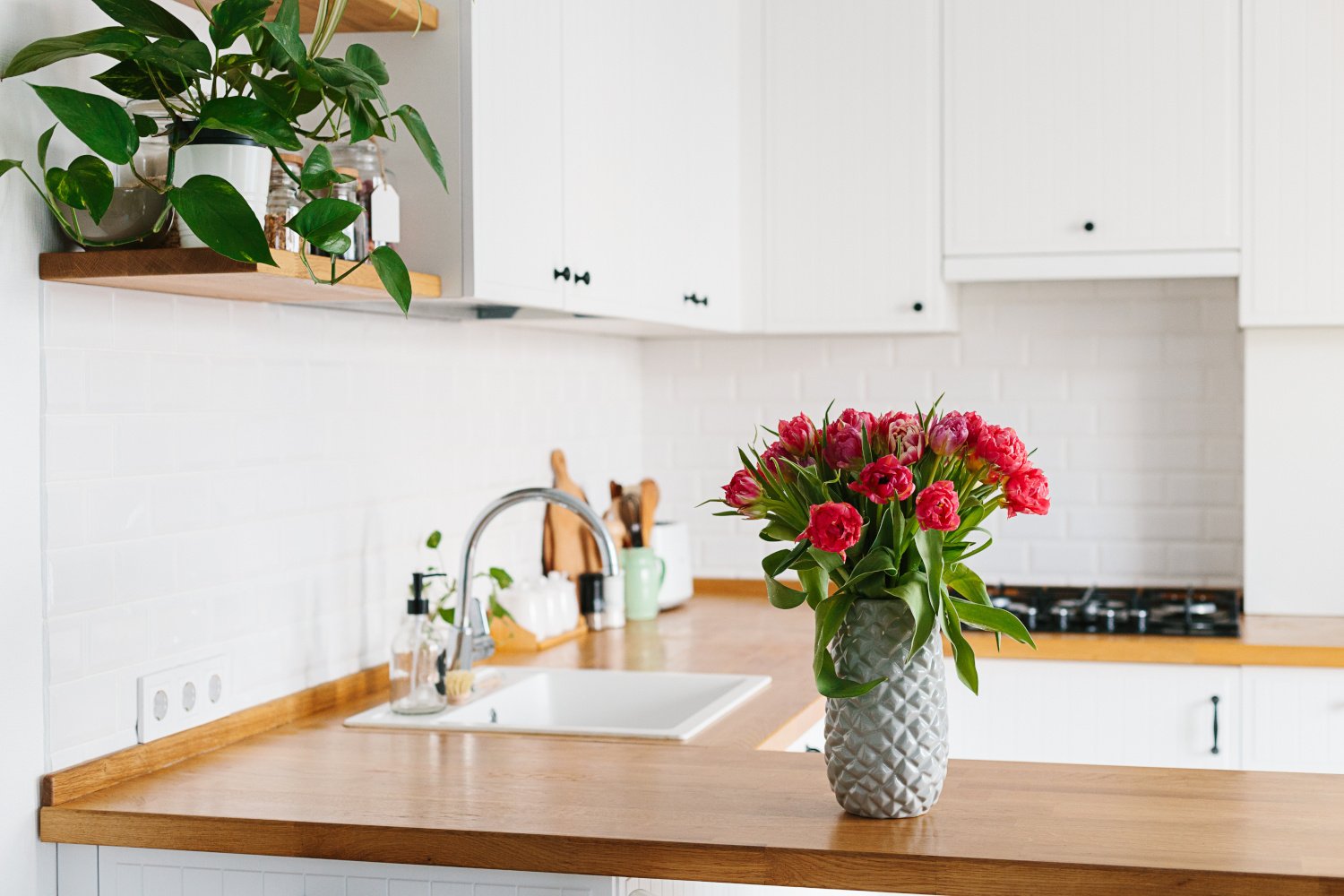

The layout: Kitchen with a working island
Good for: Medium and large kitchens
The island kitchen layout features a freestanding island. A kitchen island adds additional work space and often includes cabinets for storage. They may include appliances, such as a sink, microwave, or dishwasher—some feature a beverage fridge or wine cooler. Bonus: You can turn your island into an additional dining area by placing bar stools around it.
However, while you can build a kitchen island for most kitchen layouts, many kitchens won’t have the room to accommodate one. After all, they take up a lot of space. If you are remodeling an older galley kitchen, removing a wall and adding an island can help make the space breathe more and provide additional storage and counter space.
Island creates additional work and storage space
Ideal for entertaining guests
Island can double as a kitchen table
Can feel cramped if there’s limited space
More expensive to build than other types of layouts
Island Kitchen Design Example:
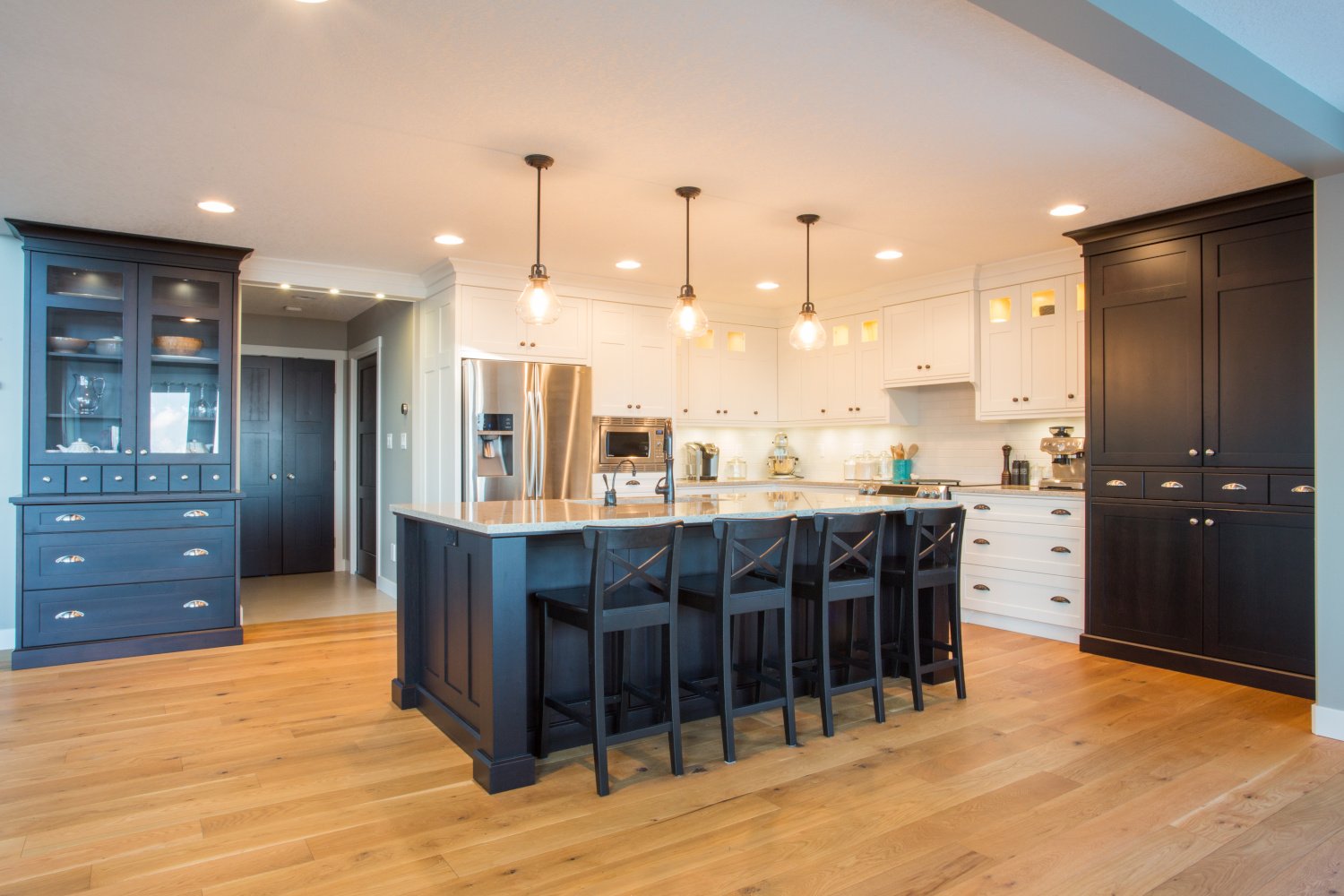
The layout: Kitchen with an island that’s connected to a wall or countertop
Good for: Medium and large kitchens, though it can sometimes work in a small kitchen
A peninsula kitchen layout features a peninsula, a kitchen island attached to a wall or countertop. Peninsulas offer many of the benefits of an island while taking up less room. This layout works well if your kitchen is in a smaller space. Depending on the placement, peninsulas may transform an L-shaped kitchen into a U-shaped kitchen or transform a U-shaped kitchen into a G-shaped or P-shaped kitchen.
Offers benefits of an island without taking up too much space
Works well for a smaller space
Adds definition and separation
Potentially prone to traffic flow issues
Can be less efficient for larger kitchens

The G-shaped kitchen layout has four sides of countertops and cabinets that form a “G” shape, with a peninsula attached to the left or right tip of the U. Because it has so much working space, the G-shaped kitchen is ideal if you want two or more people to cook together. The peninsula also offers guests a space to hang out without getting in the cook’s way.

The P-shaped peninsula kitchen is essentially the same as the G-shaped kitchen, but in the form of a “P.” The P shape is especially good for large kitchens and open-plan kitchens because you can also incorporate a table or breakfast nook into the design.
Peninsula Kitchen Design Example:
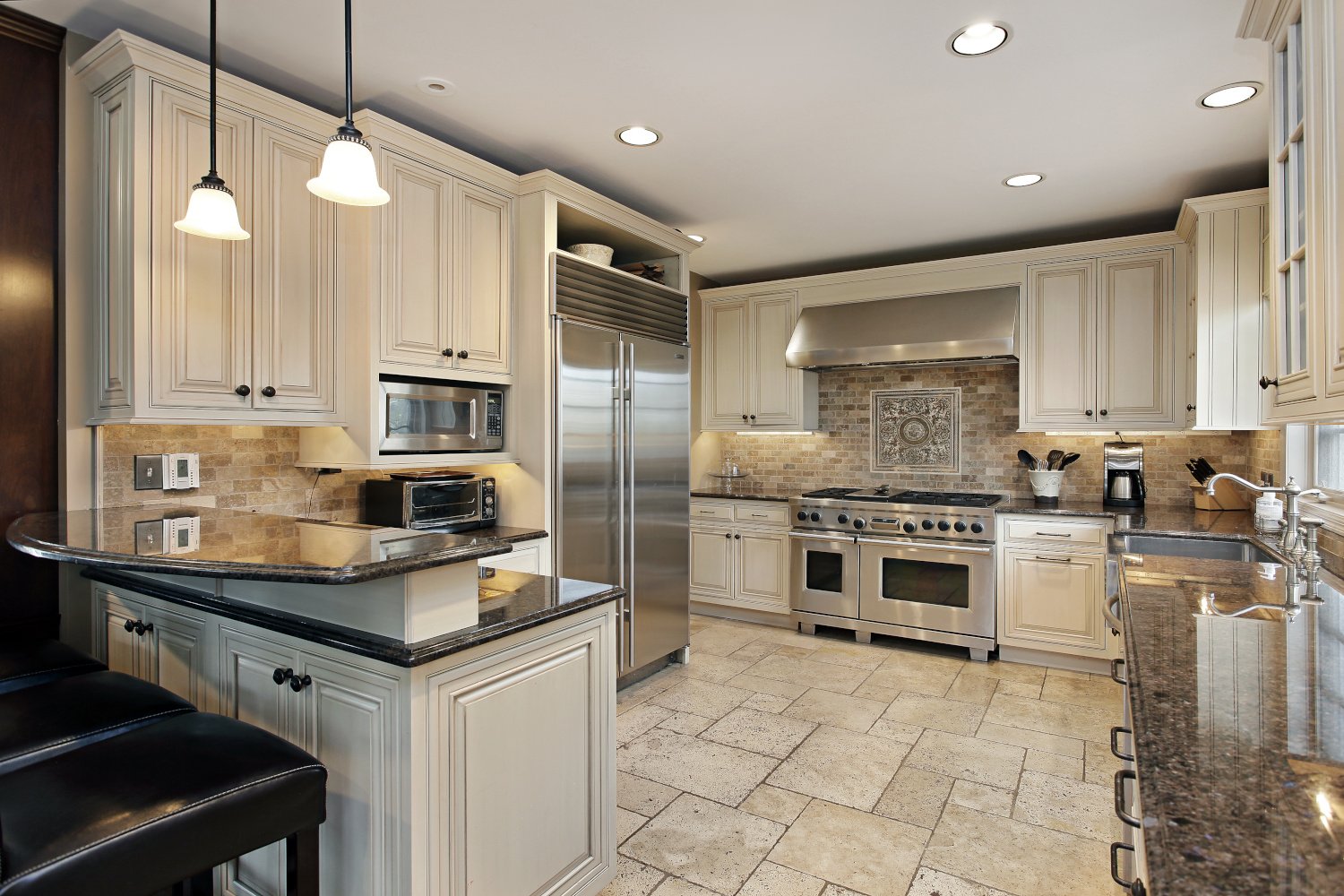
When it comes to kitchen layouts, the options are seemingly endless. Here are a few trustworthy tips that can make choosing a kitchen layout a bit easier.
It can be easy to prioritize the cool kitchen features first, like adding a gorgeous quartz countertop or installing new cabinets. However, you must consider details that impact safety before anything else. For example, if you have energetic little ones who like to run through the kitchen, you might choose a more spacious layout. You’ll also want to consider the placement of appliances like the stove and microwave, plus where you’ll store your utensils.
What you currently value in your kitchen space may not be what you’ll value in the coming years. While you may not have much use for a large dining table or cooking space now, that could change as your life evolves. So, when you’re deciding on a layout, you’ll want to look at the big picture—balancing both your present and future needs.
The “flow” of your kitchen has everything to do with where items are located and how easily you can move around your kitchen space. Think about which layout will create optimal flow based on how many people are in your family, your cooking and cleaning habits, and more. The right layout for you ultimately depends your specific needs and habits.
As we’ve discussed, the kitchen triangle is a design rule which stems from the belief that the kitchen sink, oven, and refrigerator should form a triangle. If you want to move around your kitchen freely, choosing a layout that utilizes the kitchen triangle could be a good idea. Of course, this rule isn’t set in stone. But it can still be a good framework for choosing a layout and designing the kitchen of your dreams.
From average costs to expert advice, get all the answers you need to get your job done.

Finishing an attic can make a great addition to your home. This guide breaks down the cost to finish an attic, including labor, materials, and more.

The cost to add a bedroom and bathroom can pay off with an increase in your home’s value and more space for you and your family. Costs vary by project scope.

A bidet—stand-alone, attachment, spray nozzle, or toilet combo—reduces toilet paper usage and saves money, but how much is a bidet? Here’s how much you’ll pay.

Building a bump-out addition creates more functional space in your home while also boosting its resale value. Learn more about their costs, benefits, and uses.

Bathroom tiles have a habit of wearing down quickly, but there's no need to spend thousands on a new look. Here are five fun methods to update your bathroom tile without replacing it.

An updated bathtub can give a bathroom a whole new look. Find out how much it costs to replace a bathtub in Minneapolis, MN, including prices by type and labor costs.